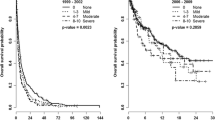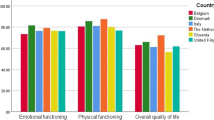Abstract
Goals of the work
Dyspnea is a common symptom in patients with advanced cancer. The goal of this study was to investigate the relationship between dyspnea and patient satisfaction with quality of life (QoL) in advanced cancer.
Materials and methods
A case series of 954 cancer patients treated at the Cancer Treatment Centers of America® was investigated. Dyspnea was measured using the EORTC dyspnea subscale. Patient satisfaction with QoL was measured using the Ferrans and Powers Quality of Life Index (QLI). The relationship between dyspnea and QLI was evaluated using multivariate analysis of variance and multiple regression analysis.
Results
Of 954 patients, 579 were females and 375 males with the median age at presentation of 56 years (range: 20–90 years). Of these patients, 66% did not respond to prior treatment. Most common cancers were breast (26%), colorectal (19%) and lung (16%). After controlling for the effects of age and treatment history, every ten unit increase in dyspnea was statistically significantly associated with 0.81, 0.16, 0.47, and 0.47unit decline in QLI health/physical, social/economic, psychological/spiritual and global function score, respectively.
Conclusions
We found that dyspnea is strongly correlated with patient satisfaction with QoL in advanced cancer. Future studies should evaluate the impact of integrative cancer care services on patient satisfaction with QoL.
Similar content being viewed by others
References
Mancini I, Body JJ (1999) Assessment of dyspnea in advanced cancer patients. Support Care Cancer 7(4):229–232
Ripamonti C (1999) Management of dyspnea in advanced cancer patients. Support Care Cancer 7(4):233–243
Dudgeon DJ, Lertzman M (1998) Dyspnea in the advanced cancer patient. J Pain Symptom Manage 16(4):212–219
Lagman RL, Davis MP, LeGrand SB, Walsh D (2005) Common symptoms in advanced cancer. Surg Clin North Am 85(2):237–255
LeGrand SB, Walsh D (1999) Palliative management of dyspnea in advanced cancer. Curr Opin Oncol 11(4):250–254
LeGrand SB (2002) Dyspnea: the continuing challenge of palliative management. Curr Opin Oncol 14(4):394–398
Roberts DK, Thorne SE, Pearson C (1993) The experience of dyspnea in late-stage cancer. Patients’ and nurses’ perspectives. Cancer Nurs 16(4):310–320
Davis CL (1994) The therapeutics of dyspnoea. Cancer Surv 21:85–98
Ripamonti C, Bruera E (1997) Dyspnea: pathophysiology and assessment. J Pain Symptom Manage 13(4):220–232
van der Molen B (1995) Dyspnoea: a study of measurement instruments for the assessment of dyspnoea and their application for patients with advanced cancer. J Adv Nurs 22(5):948–956
Reuben DB, Mor V (1986) Dyspnea in terminally ill cancer patients. Chest 89(2):234–236
Higginson I, McCarthy M (1989) Measuring symptoms in terminal cancer: are pain and dyspnoea controlled? J R Soc Med 82(5):264–267
Muers MF, Round CE (1993) Palliation of symptoms in non-small cell lung cancer: a study by the Yorkshire Regional Cancer Organisation Thoracic Group. Thorax 48(4):339–343
Dudgeon DJ, Kristjanson L, Sloan JA et al (2001) Dyspnea in cancer patients: prevalence and associated factors. J Pain Symptom Manage 21(2):95–102
Bruera E, Schmitz B, Pither J et al (2000) The frequency and correlates of dyspnea in patients with advanced cancer. J Pain Symptom Manage 19(5):357–362
Aaronson NK, Ahmedzai S, Bergman B et al (1993) The European Organization for Research and Treatment of Cancer QLQ-C30: a quality-of-life instrument for use in international clinical trials in oncology. J Natl Cancer Inst 85(5):365–376
Groenvold M, Klee MC, Sprangers MA, Aaronson NK (1997) Validation of the EORTC QLQ-C30 quality of life questionnaire through combined qualitative and quantitative assessment of patient–observer agreement. J Clin Epidemiol 50(4):441–450
Hjermstad MJ, Fossa SD, Bjordal K, Kaasa S (1995) Test/retest study of the European Organization for Research and Treatment of Cancer Core Quality-of-Life Questionnaire. J Clin Oncol 13(5):1249–1254
Ferrans CE, Powers MJ (1985) Quality of life index: development and psychometric properties. ANS Adv Nurs Sci 8(1):15–24
Ferrans CE (1990) Development of a quality of life index for patients with cancer. Oncol Nurs Forum 17(3 Suppl):15–19
Ferrans CE, Powers MJ (1992) Psychometric assessment of the Quality of Life Index. Res Nurs Health 15(1):29–38
Ferrans CE (1996) Development of a conceptual model of quality of life. Sch Inq Nurs Pract 10(3):293–304
Cella DF, Bonomi AE (1995) Measuring quality of life: 1995 update. Oncology (Williston Park) 9(11 Suppl):47–60
Osoba D (1994) Lessons learned from measuring health-related quality of life in oncology. J Clin Oncol 12(3):608–616
Osoba D, Rodrigues G, Myles J et al (1998) Interpreting the significance of changes in health-related quality-of-life scores. J Clin Oncol 16(1):139–144
Acknowledgment
This study was funded by Cancer Treatment Centers of America®. We thank Thom Wodek, Tanya Jordan, and Jody Wehrwein, our clinical research coordinators, for their contributions in the administration of the quality of life questionnaires to our patients and subsequent data entry.
Author information
Authors and Affiliations
Corresponding author
Additional information
The study was funded by the Cancer Treatment Centers of America®
Rights and permissions
About this article
Cite this article
Gupta, D., Lis, C.G. & Grutsch, J.F. The relationship between dyspnea and patient satisfaction with quality of life in advanced cancer. Support Care Cancer 15, 533–538 (2007). https://doi.org/10.1007/s00520-006-0178-7
Received:
Accepted:
Published:
Issue Date:
DOI: https://doi.org/10.1007/s00520-006-0178-7




